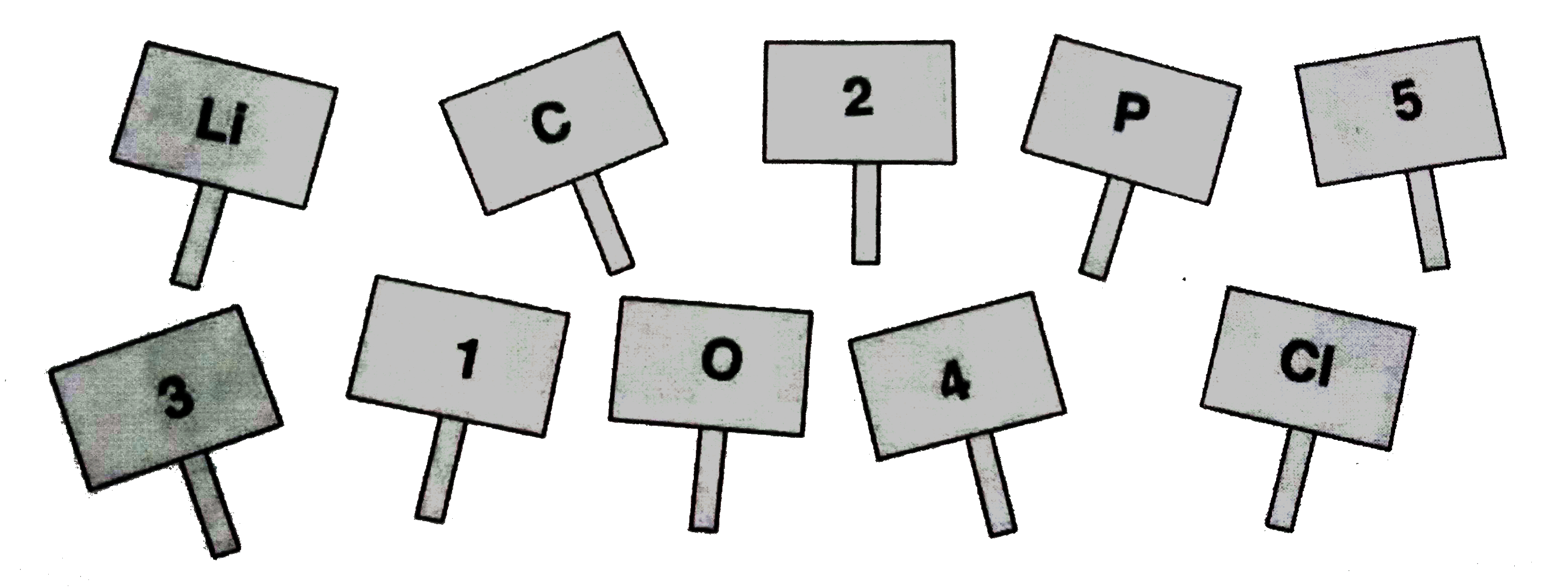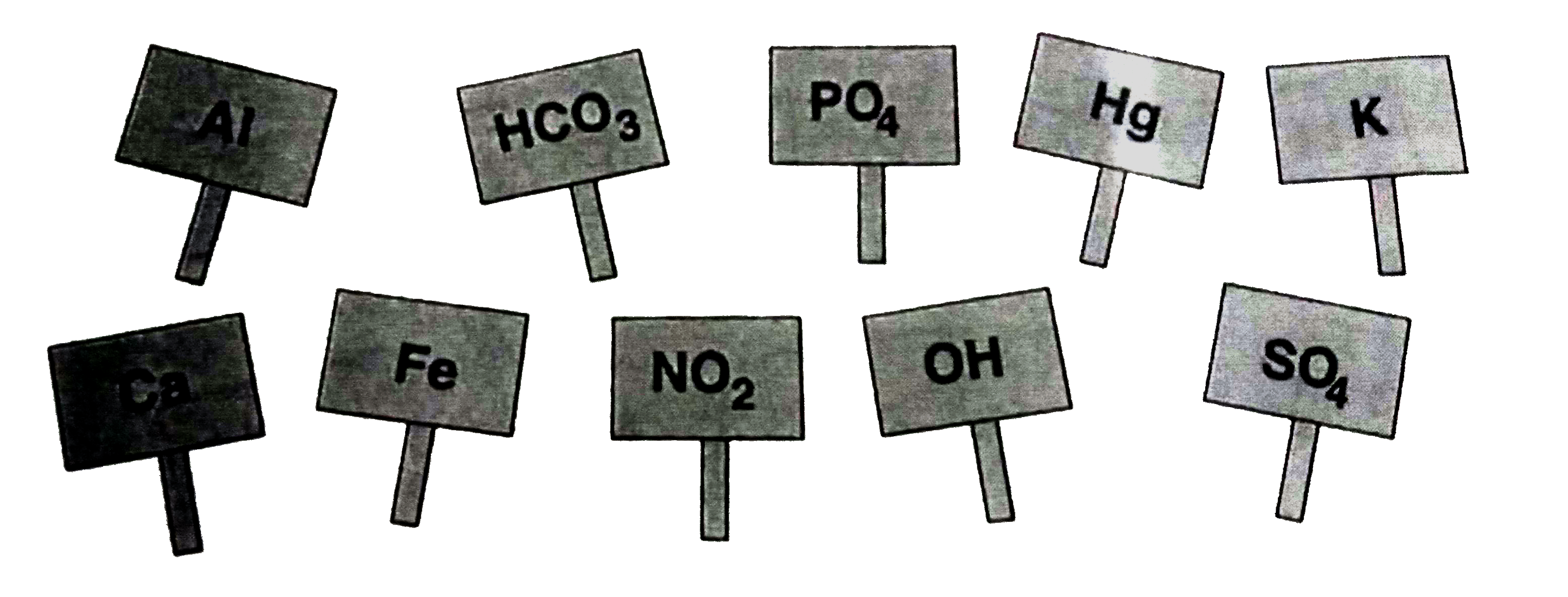Make placards with symbols and valencies of the elements separately. Each student should hold two placards, one with the symbol in the right hand and the other with the valency in the left hand. Keeping the symbols in place, students should criss-cross their valencies to form the formula of a compound.
Step-by-Step Solution:
1. Create Placards for Elements:
- Each student needs to create two placards. One placard should display the symbol of an element, and the other should display its valency.
- For example, for Aluminum (Al), the placard would show "Al" on one side and "3" (its valency) on the other side.
2. Select Elements and Their Valencies:
- Choose a few elements and write down their symbols and valencies.
- Example elements could be:
- Aluminum (Al) - Valency: 3
- Chlorine (Cl) - Valency: 1
- Sodium (Na) - Valency: 1
3. Hold the Placards:
- Each student should hold one placard with the element's symbol in their right hand and another with the valency in their left hand.
4. Criss-Cross the Valencies:
- To form a compound, criss-cross the valencies while keeping the symbols in place.
- For example, if a student is holding Aluminum (Al) with a valency of 3 and Chlorine (Cl) with a valency of 1, they would criss-cross the valencies:
- Aluminum (Al) takes the valency of Chlorine (1) and Chlorine (Cl) takes the valency of Aluminum (3).
5. Write the Formula:
- Based on the criss-crossed valencies, write the formula for the compound.
- In the example above, the formula would be AlCl3 (1 from Cl and 3 from Al).
6. Repeat with Other Elements:
- You can repeat the process with other combinations of elements, such as Sodium (Na) and Chlorine (Cl).
- Criss-crossing their valencies would give you NaCl (1 from Cl and 1 from Na).
Final Formulas:
- From the above examples, you can derive:
- Aluminum and Chlorine: AlCl3
- Sodium and Chlorine: NaCl
- Each student needs to create two placards. One placard should display the symbol of an element, and the other should display its valency.
- For example, for Aluminum (Al), the placard would show "Al" on one side and "3" (its valency) on the other side.
- Choose a few elements and write down their symbols and valencies.
- Example elements could be:
- Aluminum (Al) - Valency: 3
- Chlorine (Cl) - Valency: 1
- Sodium (Na) - Valency: 1
- Each student should hold one placard with the element's symbol in their right hand and another with the valency in their left hand.
- To form a compound, criss-cross the valencies while keeping the symbols in place.
- For example, if a student is holding Aluminum (Al) with a valency of 3 and Chlorine (Cl) with a valency of 1, they would criss-cross the valencies:
- Aluminum (Al) takes the valency of Chlorine (1) and Chlorine (Cl) takes the valency of Aluminum (3).
- Based on the criss-crossed valencies, write the formula for the compound.
- In the example above, the formula would be AlCl3 (1 from Cl and 3 from Al).
- You can repeat the process with other combinations of elements, such as Sodium (Na) and Chlorine (Cl).
- Criss-crossing their valencies would give you NaCl (1 from Cl and 1 from Na).
- From the above examples, you can derive:
- Aluminum and Chlorine: AlCl3
- Sodium and Chlorine: NaCl
Topper's Solved these Questions
Similar Questions
The students of class IX have made placards showing the symbols of some elements and valencies of these elements. These placards somehow got mixed up as shown below :

On this basis of these placards the chemistry teacher, Mrs. Shanti, asked a student Vikas to answer the following questions :
(a) Choose the symbol of an element from among the placards which exhibits valencies of 3 and 5. What is the name of is the name of this element ? Is it a metal or a non-metal ?
(b) Choose the symbol of an element from the given placards which shows a valency of 2. What is the name of this element ? Is it a metal or a non-metal ?
(c) Work out the formula of the compound formed between the element of valency 3 and element of valency 2. Also name this compound
(d) What values are displayed by Vikas in this episode ?View SolutionPratap is a student of class IX in a city school. He has recently studied the writting of formulae of ionic compounds in the class. Pratap has made some placards for a science quiz showing the symbols of some elements and some ions but forgot to write the electric charges on the ions. Moreover, the placards made by Pratap got mixed up as shown below :

Based on these placards, the chemistry teacher, Mr. Suri, asked Pratap to answer the following question :
(a) Choose the symbol of the element from among the placards which can form divalent and trivalentcations. Name this element. Also write the symbols of these cations along with their charges
(b) Choose the symbol of a divalent anion from among the given placards. what is the name of this anion. Also write the symbol of this anion alongwith its charge
(c) Work out the formula of the ionic compound formed between the divalent cation and divalent anion described above. Also name the compound formed
(d) Work out the formula of the ionic compound formed between the trivalent cation and divalent anion described above. Also name the compound formed
(e) What values are displayed by Pratap in this episode ?View Solution
Knowledge Check
- Question 1 - Select One
Chemical formula of a molecular compound represents the actual number of atoms of different elements present in one molecule of the compound. With the help of symbols and valencies or charges, a formula can be made. First write the symbol such as positive ion to the left and negative ion to the right and then criss cross the valencies or charges . Thus in this way we can write a chemical formula.
The valency of A is 2 and B is 1, a chemical formula formed by both of them will beAAB2BA2BC2ABD2BA - Question 2 - Select One
Chemical formula of a molecular compound represents the actual number of atoms of different elements present in one molecule of the compound. With the help of symbols and valencies or charges, a formula can be made. First write the symbol such as positive ion to the left and negative ion to the right and then criss cross the valencies or charges . Thus in this way we can write a chemical formula.
The symbols needed to form barium chloride areAB, ClBBa, ClCBe,ClDnone of these - Question 3 - Select One
Chemical formula of a molecular compound represents the actual number of atoms of different elements present in one molecule of the compound. With the help of symbols and valencies or charges, a formula can be made. First write the symbol such as positive ion to the left and negative ion to the right and then criss cross the valencies or charges . Thus in this way we can write a chemical formula.
The charge on Cl in FeCl3 isA+1B−1C+3D−3
Case 1: A chemical equation is the representation of chemical change in terms of symbols and formulae of reactants and products. The substances which react are written on the left hand side of the arrow and are termed as reactants while the substances produced as result of reaction are called products and are written on the right hand side of the arrow. The arrowhead shows the direction of the reaction. A chemical equation in the whcih the number of atoms of each element on reactant side is equal to that on the product side is said to be balanced.

Which of the following statement is incorrect regarding th significance of the chemical equations?View SolutionCase 1: A chemical equation is the representation of chemical change in terms of symbols and formulae of reactants and products. The substances which react are written on the left hand side of the arrow and are termed as reactants while the substances produced as result of reaction are called products and are written on the right hand side of the arrow. The arrowhead shows the direction of the reaction. A chemical equation in the whcih the number of atoms of each element on reactant side is equal to that on the product side is said to be balanced.

Among the following the correct balanced equation isView SolutionCase 1: A chemical equation is the representation of chemical change in terms of symbols and formulae of reactants and products. The substances which react are written on the left hand side of the arrow and are termed as reactants while the substances produced as result of reaction are called products and are written on the right hand side of the arrow. The arrowhead shows the direction of the reaction. A chemical equation in the which the number of atoms of each element on reactant side is equal to that on the product side is said to be balanced.

In which of the following equation the mass is not same on both the sides?View SolutionCase 1: A chemical equation is the representation of chemical change in terms of symbols and formulae of reactants and products. The substances which react are written on the left hand side of the arrow and are termed as reactants while the substances produced as result of reaction are called products and are written on the right hand side of the arrow. The arrowhead shows the direction of the reaction. A chemical equation in the whcih the number of atoms of each element on reactant side is equal to that on the product side is said to be balanced.

How is input of energy represented in chemical equation ?View SolutionThe name of a substance is given to a student. He was asked to write its formula. What is the systematic method to be followed to derive the formula? Arrange the given statements in a proper sequence to obtain the formula.
(1) Symbol of positive ion or radical should be placed to the left-hand side and symbol of negative ion should be placed to the right-hand side.
(2) Place the valency with charge of respective radicals on the top right hand corner of their symbols.
(3) Write the symbols of the respective ions or radicals present in the given compound.
(4) Criss-cross the valency on the lower right hand side of ions/radicals.
(5) A radical consisting of more than one element has to be enclosed within the brackets if the respective number attained in criss-cross is more than one.
(6) No space should be left in between oppositely charged ions while writing the formula.View Solution

